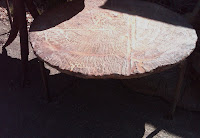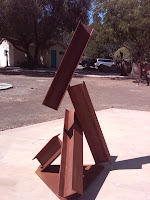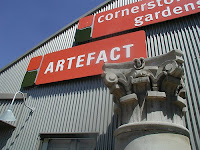This series was going to be a IV part series but I just can't get it all in...there were so many great stores in the Sonoma Valley, and Cornerstone Sonoma was just the first place I stopped! Here's to covering it all in VII parts (subject to change!).
And, just so you know, that is not my ride, pictured at right, but one of what seemed like a hundred limo's that we saw that day chauffeuring the glitterati and oenophiles around the Sonoma Valley.
Can't give you a ton of info on this shop as I didn't walk through it, but I did look in the windows after spotting the great tables by Wyatt Ellison, pictured far below.
I checked out the Opia Home web site and it confirmed what I had seen through the windows, Asian antiques and reproduction furniture, stone carved figurines on stands, and framed art. Turns out the art is actually Giclee prints (French; pronounced zhee-klay; see definition below) by Jie Wei Zhou (b. 1962), whom their web site refers to as "A Chinese Master".
I first saw original
Zhou paintings several years ago back in Santa Fe at the
Manitou Galleries (
http://www.manitougalleries.com/). The artists bathes his subjects in an almost mystical light from an unseen source. The Asian subjects themselves seem to have lost most of their native facial features and are portrayed as more cosmopolitan than the
typical Asian genre paintings.
The 16" x 20"
Zhou oil painting,
Peaches and Roses, 2003 (shown below left) is offered for sale by
Manitou Galleries on the
Ask Art web site (
http://www.askart.com/) for $4,500. At
Opia Home, the
Giclee print,
Ming Jar (shown below, right), also 16" x 20", sells for $600.
____________________________________________________________________
There is never a substitute for doing your own research on an art object or artists prior to purchasing. The exercise can be gratifying, or a nightmare averted, and through research you can glean a sense of the works approx. value.
Here's a brief crash course on Giclee Prints:
Images that are printed from high resolution digital scans and printed with archival quality inks onto canvas, fine art, and photo-base paper. The process provides color accuracy and the Giclee prints are typically printed with professional 8 to 12-Color ink-jet printers.
The Advantages: To the artists when it's not feasible to mass produce their work, but they want to reproduce their art as needed, or on-demand. Once an image is digital archived, additional reproductions can be made with minimal effort and reasonable cost.
The Quality: Giclee print quality rivals that of traditional silver-halide and gelatin printing processes and is commonly found in museums, art galleries, and photographic galleries.
The Market: Giclee prints can be found at the Metropolitan Museum, and the Museum of Modern Art in New York. Recent auctions of giclee prints have fetched $10,800 for an Annie Leibovitz, $9,600 for a Chuck Close, and $22,800 for a Wolfgang Tillmans (Source: Phillips de Pury & Company, New York, Photographs Sale, April 23/24 2004.
_______________________________________________
What in the world am I doing? The thing that I most wanted to talk about from this shop has been pushed to the end of this article. Crazy me!

Okay now, I'm back on track. And, here we go:
Out front of the
Opia Home shop were these great tables by Marin County steel artisan Wyatt Ellison (
http://www.sculpturesforliving.com/). Ellison calls his work "Elemental Art".
I was drawn to the balance of the design aesthetics and physical elements of the tables, their unique steel bases and their organic wood tops; and the great looking steel containers (pots), below.
I thought his prices were reasonably priced, and had they been in some tony New York boutique and not sitting in the dirt in the Sonoma Valley, I suspect they would have been two to three times their asking price.
Pictured below is the table that grabbed my attention, the Fisherman Table by Ellison. Eucalyptus wood top, on a rusted steel base; 30"Dia x 30"T; $990.

 Part IV of VII: My Sonoma Wine Country Tour, without touring one vineyard or tasting a drop of wine—what a concept!
Part IV of VII: My Sonoma Wine Country Tour, without touring one vineyard or tasting a drop of wine—what a concept!

 Whew! Now, for the last stop before leaving the town of Sonoma, and after a late decision to make a quick right turn into the driveway of sculptor Hossain Amjadi (http://www.ha-artforms.com/).
Whew! Now, for the last stop before leaving the town of Sonoma, and after a late decision to make a quick right turn into the driveway of sculptor Hossain Amjadi (http://www.ha-artforms.com/).  The narrow dirt driveway led us over a culvert, through a pair of artful gates, past a house on the left, and finally to an empty graveled parking area next to what looked like a small office in a painted white out-building.
The narrow dirt driveway led us over a culvert, through a pair of artful gates, past a house on the left, and finally to an empty graveled parking area next to what looked like a small office in a painted white out-building. 














































